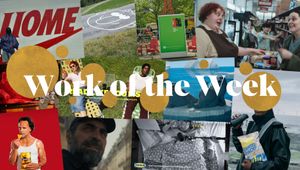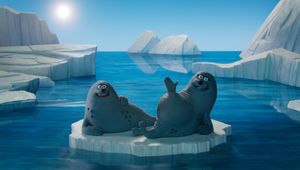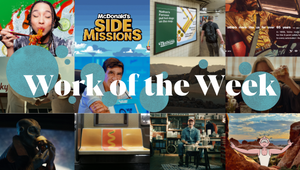
Giraffe Sisters Turn Family Chaos Into Surreal Short Film

Where The Buffalo Roam (WTBR) directing duo Giraffe Sisters announces the wide digital release of their latest short film, Summer of Fellini. The surrealistic film paints a portrait of the sisters’ experience growing up together as artists against the backdrop of their parents’ fractured relationship. The film stars the directors, Nicola and Juliana Giraffe, alongside their actual parents.
Conceived as a creative escape during a family trip to Europe for a wedding with their separated parents, Summer of Fellini culminated in something more profound than the Giraffe Sisters could have envisioned: a reimagining of their origin story - from conception and birth to individuation - expressed through a series of poetic, symbol-laden vignettes.
“Our parents’ rollercoaster relationship not only shaped our deep bond as sisters from a young age, but also our worldview as filmmakers - using the craft as a form of escape and expression,” says Nicola Giraffe. “So, going into this trip with tensions running high, the idea of retreating into an imagined world together felt natural.”
“We made this film without a plan, just an inspiration,” adds Juliana Giraffe. “Putting ourselves into the art and adopting these characters gave us the freedom to be more comfortable with ourselves, to escape our animosities, turmoil, and trauma, and just be present. It ended up being a therapeutic release for the whole family.”
Summer of Fellini was shot at picturesque locations across Europe. In Sevilla, Spain, they shot vignettes of their parents in solitude, such as their father walking among ancient statues and their mother hobbling down the hot street in one red shoe.
The surreal cow scene, in which the sisters are dressed up as 'good matadors,' was filmed in Cornwall, England - the same location where they shot their first home movies as little girls during summer visits to their family farm.
“Behind the farm, there’s a hill we often hiked, and we’d sometimes see cows, but not always,” explains Juliana Giraffe. “We asked our dad to drive us there, hoping to film them, and to our surprise, a whole herd rushed toward us. It was magical, and we just started crying and hugging each other.”
The sea shots were filmed along Portugal’s Algarve coast, where the sisters emerge from the water in perfect sync, followed by a series of scenes in which they mirror each other’s activities, such as shell collecting, sunbathing, and miming.
“We aren’t twins in real life, but in the film, we are both born from the ocean at the same time,” says Nicola Giraffe. “So much of our work is collaborative, and to have this moment together as characters in the film as total equals felt like a rebirth for us both in real life.”
At and around their hotel in Porto, Portugal, they filmed vignettes of the parents’ various sojourns: the mother admiring a painting that delightfully comes to life while the father naps on a chaise longue; a bittersweet moment sharing ice cream by a fountain; and a quiet walk through a botanical garden, hand in hand.
WTBR’s Simon Mowbray handled the VFX, enhancing the film’s surrealism, as seen with the birds coming alive in the painting. He also performed compositing and clean-up for the run-and-gun shoot.
“We rarely work with VFX artists, so collaborating with Simon was exciting,” says Nicola Giraffe. “We knew we wanted the film to depict our family as the only human subjects you see, emphasising them in these vast spaces. It wouldn’t have been possible without VFX, and his talents truly elevated the film.”
Summer of Fellini is set to a melancholic original score composed by Sundance Jury Prize winner Max Whipple Atropia and produced by Greg Hartunian. The music was inspired by the passing of his and Juliana’s dog, Fellini, who is seen in the film’s final shot, taken the day before he passed away.
“Toeing the line between art and real life was a recurring theme we explored in this film,” concludes Juliana Giraffe. “Max’s score reflects the grief he was experiencing, which is why the music is so emotional. The music serendipitously added another layer to the idea of art as a form of healing that kept surfacing.”















